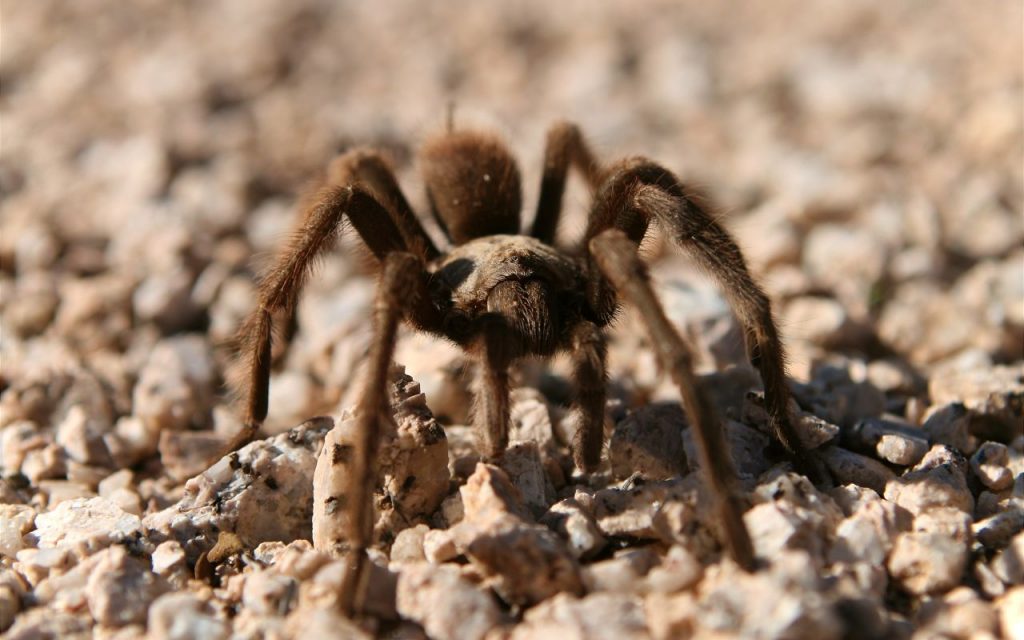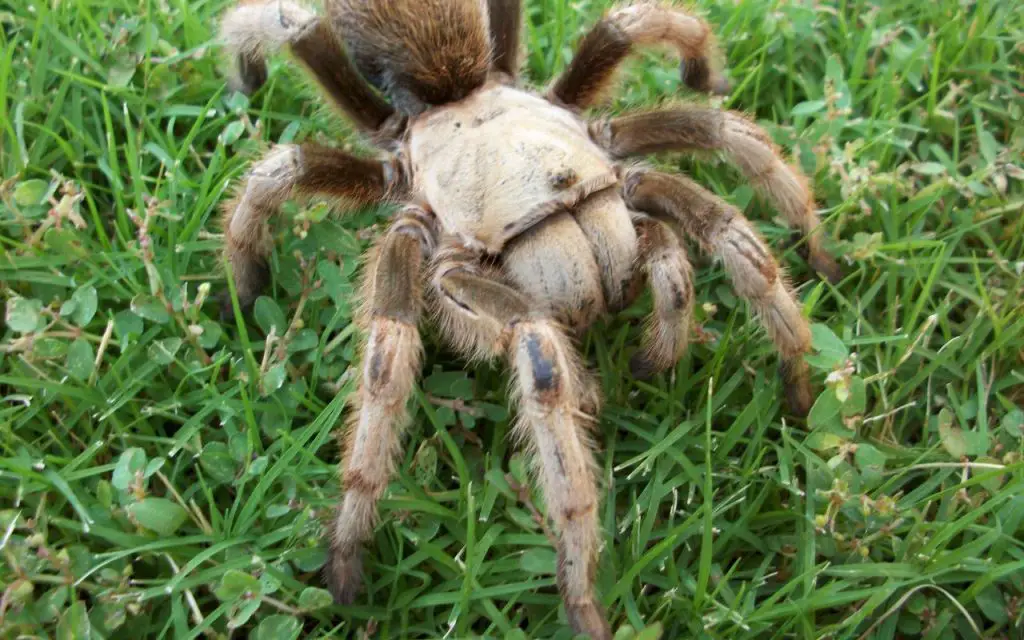Last updated on February 1st, 2023 at 09:54 am
They’re popular as pets because of their docile nature, but what do Arizona Blonde Tarantulas eat? Let’s a look at their diet in the wild and captivity…
In the wild, Arizona Blonde Tarantulas eat grasshoppers, beetles, and other small spiders and arthropods. They have also been known to eat bird eggs and lizards on occasion. In captivity their diet can be a lot more simple. You can feed them crickets, waxworms, locusts, mealworms and Dubia roaches.
To properly care for your desert blond tarantula, you will need to feed it live crickets and other insects that are small enough for the spider to eat.
You should also ensure that the crickets are fed nutritious foods, so your spider gets all the nutrients it needs.
Arizona Blonde Tarantula diet
The Arizona Blonde Tarantula is a relatively small species of spider, typically only reaching about 3 or 4 inches in length. As its name suggests, this tarantula is found primarily in the desert regions of Arizona.
The Arizona Blonde Tarantula primarily feeds on live insects, such as crickets, roaches, and mealworms. It is important to note that the insect should be smaller than the spider’s body for the tarantula to eat it easily.
If you keep an Arizona Blonde Tarantula as a pet, you will need to provide it with a regular diet of live insects.
While some tarantula owners choose to feed their spiders pre-killed insects, it is generally recommended that you provide live prey instead.
This will help to ensure that your tarantula stays healthy and active.
The desert blonde tarantula is a small to medium-sized spider that is found in the deserts of North America. They are brown with yellow stripes on their legs and have a brown or tan carapace.
These spiders can live for up to 20 years and grow to be 3-4 inches in length. Tarantulas are not harmful to humans, but their bites can be painful.

Buying food for your tarantula
- When looking for food for your tarantula, choosing something high in protein is important.
- The best food options for tarantulas include crickets, mealworms, and cockroaches.
- It’s also important to ensure that the insects you choose are gut-loaded and healthy.
- To ensure that your tarantula gets the balanced diet it needs, you should offer various types of insect prey.
- Always consult an expert before feeding your tarantula anything new or unusual.

How often to feed your tarantula
The frequency of feedings has no hard and fast rule. Some tarantula owners feed their pets daily, while others only offer food every four to seven days.
Young spiders typically grow quickly and can be fed more frequently than adults. However, adult tarantulas must only be fed every seven to ten days.
The next time you need to feed your spider, wait until you have live prey. Then, simply drop the prey near your spider.
If the food isn’t eaten within 24 hours, remove it so that it doesn’t begin to stress your spider out. Plus, always have a small dish of clean water in the enclosure.
Make sure your spider can access the dish and leave it easily to avoid any accidents. Change the water every day.
It is also important to note that tarantulas will not eat if they are in premolt or post-molt stages. If your tarantula stops eating for an extended period, it is likely preparing to molt.
Molting can be stressful for tarantulas, so it is best to refrain from handling them during this time. Tarantulas are carnivorous predators that usually hunt at night.
They will eat almost anything they can subdue and kill in the wild, including insects, lizards, rodents, and even small birds. However, captive tarantulas are typically fed a diet of live insects.
While crickets are the most common food source, other common options include mealworms, crickets, waxworms, and pinkie mice. Depending on the size of the tarantula, a single feeding may consist of anywhere from one to several dozen insects.

Can you feed a tarantula too much?
As with most animals, it is possible to overfeed a tarantula. This can lead to several problems, including increased susceptibility to injury and inducing fasting behavior.
Additionally, routine overfeeding may shorten the spider’s lifespan. However, as long as the tarantula is fed appropriately, there should be no cause for concern.
Tarantulas are hearty creatures that can thrive on various diet plans. As long as you take care not to overfeed, there will be no problem with proper nutrition.

How many crickets should I feed my tarantula at once?
After molting, all tarantulas are at their hungriest. For the first week or two following a molt, increase the number of crickets you feed your tarantula to three per week.
Beyond that, most species of tarantulas do well on a regimen of no more than two crickets per week. If you notice your tarantula is not eating as much as usual or seems thinner than normal, check to see if it is due for a molt.
A tarantula getting ready to molt will usually stop eating altogether for some time. Once the molting process is complete, it will be hungry and you can resume feeding it according to schedule.

Arizona Blonde Tarantula not eating
There could be a few reasons why your Arizona Blonde Tarantula isn’t eating:
- One possibility is that the tarantula is molting, which is a process of growing a new exoskeleton. During molting, the tarantula will stop eating and may retreat to its web or hideout until it has completed the process.
- Be sure to check that the water dish is full and clean and that there are plenty of live insects available for your tarantula to eat.
- If you’ve ruled out molting and lack of food or water as potential causes, then your tarantula may be sick.
How long can a Arizona blonde go without eating?
It is difficult to give a definitive answer to this question as it depends on several factors. It includes factors such as the age and size of the spider, the temperature and humidity of its environment, and food availability.
However, adult spiders can survive for several months without food, while younger spiders may need to eat more often, about once every 4 to 7 days.
In extreme circumstances, such as when temperatures are very cold or very hot, spiders may enter a state of dormancy where they do not eat.
However, even in these conditions, most spiders will eventually die if they do not have access to food. Therefore, it is safe to say that Arizona blondes can go for a significant period without eating.

How long do Arizona Blonde Tarantulas live?
The typical lifespan of an Arizona Blonde Tarantula is 10 to 12 years for males and twice as much for females.
However, captive tarantulas have been known to live much longer than their wild counterparts.
Tarantulas are generally long-lived creatures, and the Arizona Blonde Tarantula is no exception. With proper care, your tarantula can enjoy a long and healthy life.

Arizona Blonde Tarantula temperature
Arizona Blonde Tarantula is fairly tolerant of temperature fluctuations and can survive in various conditions.
However, it is best to maintain a tank temperature between 75 and 80 degrees Fahrenheit for optimal health and growth. If your tarantula is way too cold it won’t eat at all.
Fluctuating too much outside of this range can lead to stress and potential health problems down the road. It is important to remember that these spiders are nocturnal creatures and do not require direct sunlight.
Too much light can be harmful to their delicate skin. Therefore, when setting up their enclosure, be sure to provide plenty of hiding places and shadowy areas for them to retreat to during the day.
Following these simple guidelines can provide your Arizona Blonde Tarantula with the ideal environment for a long and healthy life.

FAQ relating to what Arizona Blonde Tarantulas eat
Do Arizona blonde tarantulas need heat?
Native to the desert regions of the southwestern United States, this spider is well-adapted to hot, dry conditions.
As a result, many assume that this tarantula species requires a heated enclosure to thrive.
However, this is not the case. While temperatures in the wild can often exceed 100°F, Arizona blonde tarantulas are just as happy at room temperatures like 65°-80°F.
This spider can even tolerate brief periods of cooler weather without ill effects.
How long do desert blonde tarantulas live?
The lifespan of a desert blonde tarantula depends on its sex. Male tarantulas typically live 10 to 12 years, while females can live twice as long.
These spiders are native to the deserts of North America, where they build burrows and hunt for prey. While they are not considered dangerous to humans, their bites can be painful and cause swelling.
Desert blonde tarantulas are relatively easy to care for, making them popular pets. If you consider getting one of these spiders as a pet, be prepared for a long-term commitment, as they may outlive you.
What does a Desert Blonde Tarantula eat?
Desert blonde tarantulas are carnivorous and eat insects, lizards, and small mammals. They use their strong jaws to crush their prey before injecting it with venom.
The venom paralyzes the prey and breaks down its internal organs, making it easier for the tarantula to digest. Tarantulas typically hunt at night, when their prey is most active.
During the day, they hide in burrows or under rocks to avoid becoming prey themselves. The pet desert blonde tarantula is usually fed crickets, mealworms, and other small insects.







